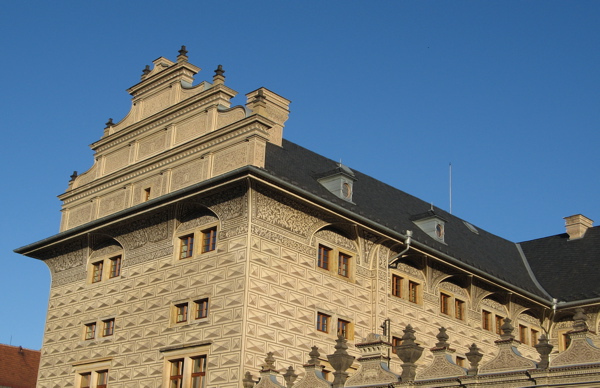We had stayed in town a little longer
than we should have, so we had to rush back to get Gerald to the
workshop (sort of) on time. Elyse went on a (successful)
reconnaissance mission for luggage lockers at the train
station from which we would be leaving the next night. Then she went
into town and headed toward the Jewish quarter. Being
navigationally-challenged, this took a little longer than she had
hoped, but she was able to find it (and some lunch) eventually.
There are claims that Jews have been in Prague since about 135
AD; historical sources would place it around the 10th century. In
any case, Jews were a part of the community for a long time and many
prospered. A walled ghetto around the Jewish community was formed
in the 12th century and every evening a portcullis would be lowered.
Although the walls were built to keep Christians "safe from
touching Jew", they proved a useful defense for the Jews, especially
around Easter-Passover when Christians feared that Jews would steal
Christian babies to use as their Passover lamb. However, the
walls did not stop the pogroms (3000 were massacred during one in 1389 - over
half of the inhabitants at the time), accusations of ritual murders or
the occasional banishments that would be a part of the Jewish history
in Prague. In 1784 Emperor Joseph II "opened the gates" hoping to
destroy the community by banning the use of Hebrew or Yiddish in
business and abolishing separate schools. Eventually rich Jews
moved out of the ghetto and poor Christians moved in. By the end
of the 19th century it was mostly slums and the government destroyed
most of the buildings. Only six synagogues, the old town hall and the
cemetery survived. As for the community itself, there had been
about 120,000 before 1939. Of the 90,000 or so who stayed in the
area, only 10,000 survived WWII.
The old cemetery is estimated to have about 20,000 people buried in up
to 12 subterranean levels. It is a jumble of tombstones and the
oldest known plot dates from 1439. There are two different groups
of synagogues/institutions that one can visit. Knowing she only
had time for one group, Elyse started at the Old-New Synagogue, one of
the oldest synagogues in Europe (from 1270) and one that is still used
today by the Orthodox community here. It is a relatively small,
Gothic building with six vaults that have a five ribs each (versus four
that some say might have resembled a cross too much after the 14th
century pogrom). It is simple and elegant, with abbreviated
biblical versus painted on the walls serving as the only "decoration" other than a red cloth
banner. The banner has a Jewish star on it surrounding the Jewish
hat that served as a symbol of the community in the 15th century.
It was an eerie feeling to sit in a place that has been used for
so long and that has seen so much sadness. Photos were not
allowed, but there are pictures online if you're curious.
The second synagogue in this "group", the Jerusalem Synagogue, was
actually located in another part of town, so Elyse headed over there.
This building dates from 1899 and the final renovations were
completed in 1905. It is very colorful and was a bit of a shock
to the system after the austere interior of the Old-New Synagogue.
But it was easier to imagine the sabbath services and holiday
celebrations taking place here. There was an exhibit at the
synagogue of a
private collection of postcards that depicted Jewish buildings (mostly
synagogues in central and eastern Europe) and people since the 17th
century or so. It showed a fascinating mix of architectural
styles for the synagogues and a glimpse of the vibrant Jewish life in
this area of the world before WWII destroyed so much of it.
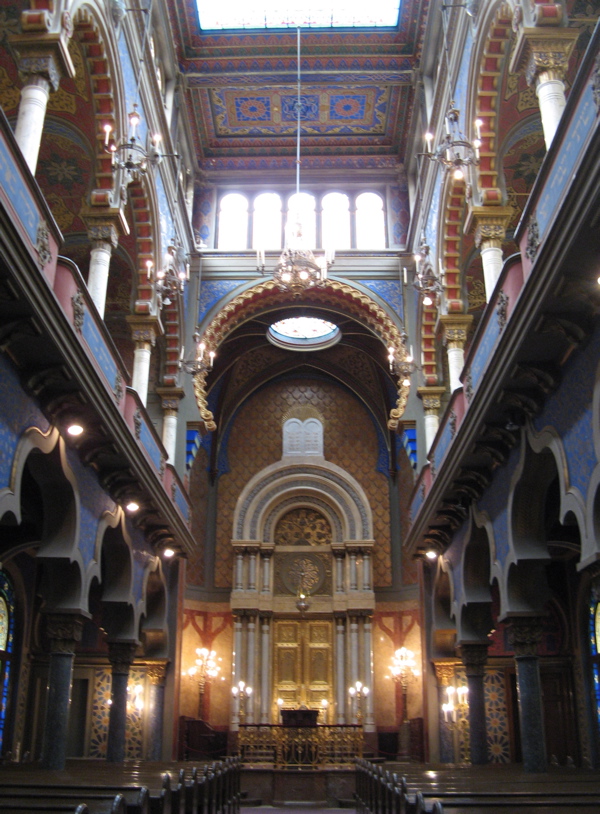
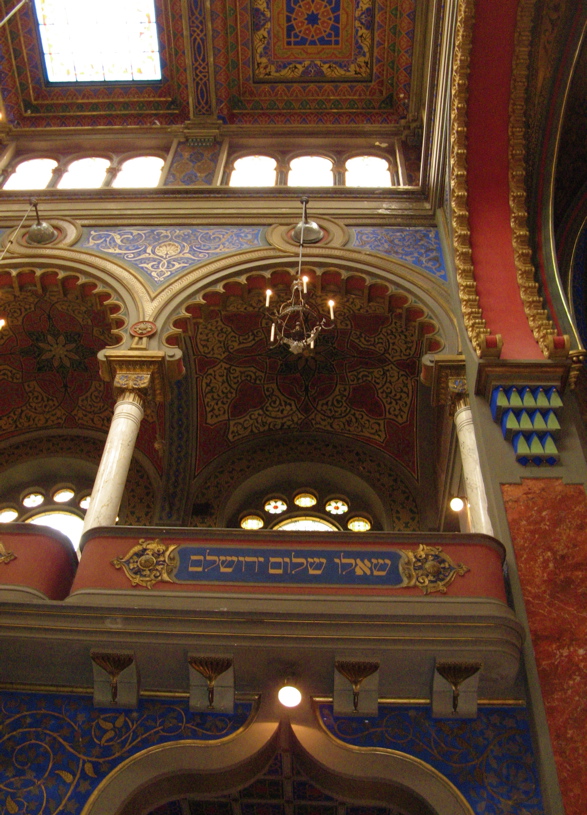
We met back at the pension, rested for a
little while and then headed into town for dinner. We had read
about a place called Cafe Savoy and it ended up being as beautiful (art
deco decorations) and good as we'd hoped. After dinner, we
decided to take the funicular up to the top of Petrin Hill. There
weren't the panoramic views we had hoped for (those were at the
restaurant located at the first stop on the funicular), but there were
beautiful rose gardens, so we walked around them (and walked a
labyrinth painted onto the ground) for a while before heading back
down. The stop for the funicular was right near the river, so
went over there to watch the sun set behind the castle. As you can see below, it was
beautiful. The
Old Town Hall area also looked even more amazing at night (below, right).
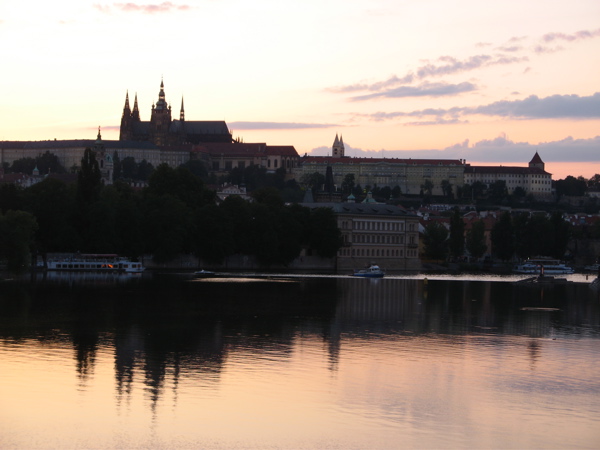

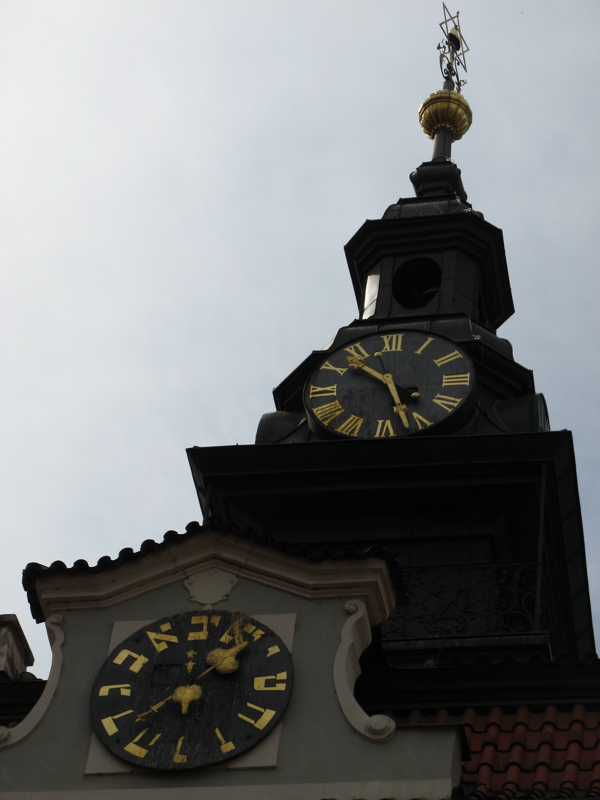
We had booked tickets on an overnight train from Prague to Heidelberg so
that we could have a full day exploring the city together. So we took our luggage to the
train station and put it in a locker for the day. We decided to
spend the day wandering around town rather than going into museums and
galleries. We headed first to the Jewish quarter and explored
what little is left as evidence of the ghetto that had been there.
We noticed that the Jewish town hall has a clock with
Hebrew letters that runs backwards (photo right) - wild! The
streets in the area have been altered over the years so that now they
are wide and lined with beautiful, large buildings. There is
clearly a lot of wealth in the area too. The guidebook led us to
a nearby area around the convent of St. Agnes (the oldest Gothic
building in Prague; the convent was founded in 1233) that had more of
the narrow alleys that would have been the norm in the ghetto. We
skipped the gallery there, but enjoyed the ambiance of the area (and
the lack of crowds!).
The book's walk guided next to the Church of St. James, founded in 1374.
It had a few surprises in it. The first was that the
interior (below, left) included 21 huge Baroque altars running along the center aisle
and all facing the door (rather than in niches/chapels facing the
center as we're used to). They were imposing, but somehow
manageable given the scale of the place. But that was nothing
relative to the "decoration" just to the left of the main doors: a
human forearm dangling from a chain. Why
is there a human forearm dangling from a chain in a church, one might
ask? The story is that a thief tried to steal the jewels of the
Madonna on the high altar of the church, but she would have none of
that and hung on until someone cut off the thief's arm and hung it up
as a reminder of religious justice. It's pretty disgusting, and we didn't want you to
miss out (or think we were lying), so look at the photo below, right.
